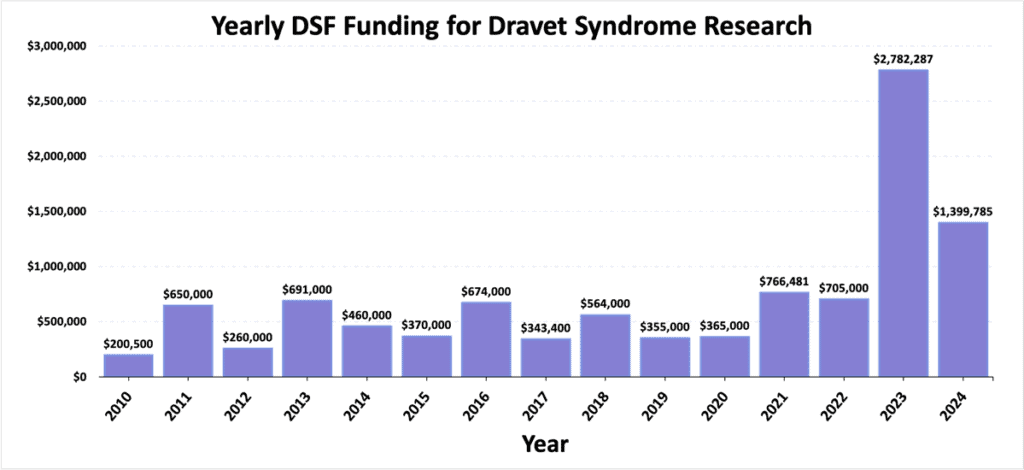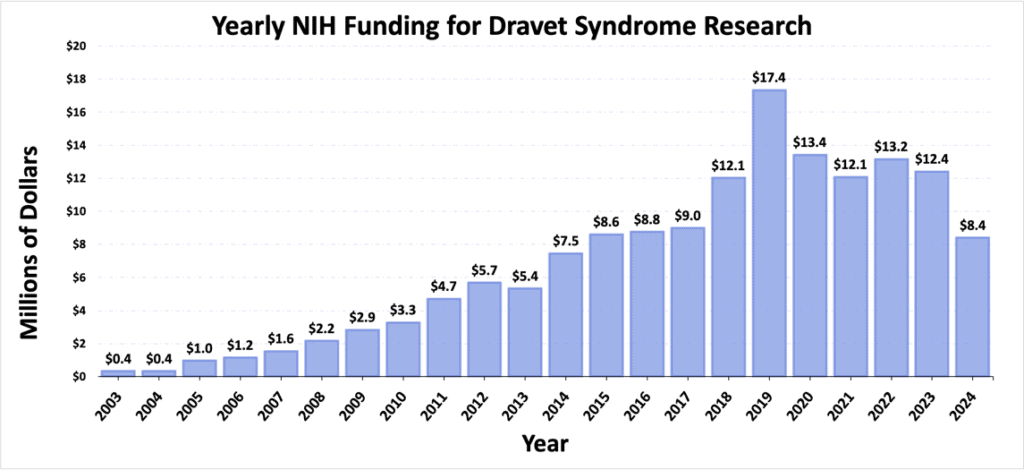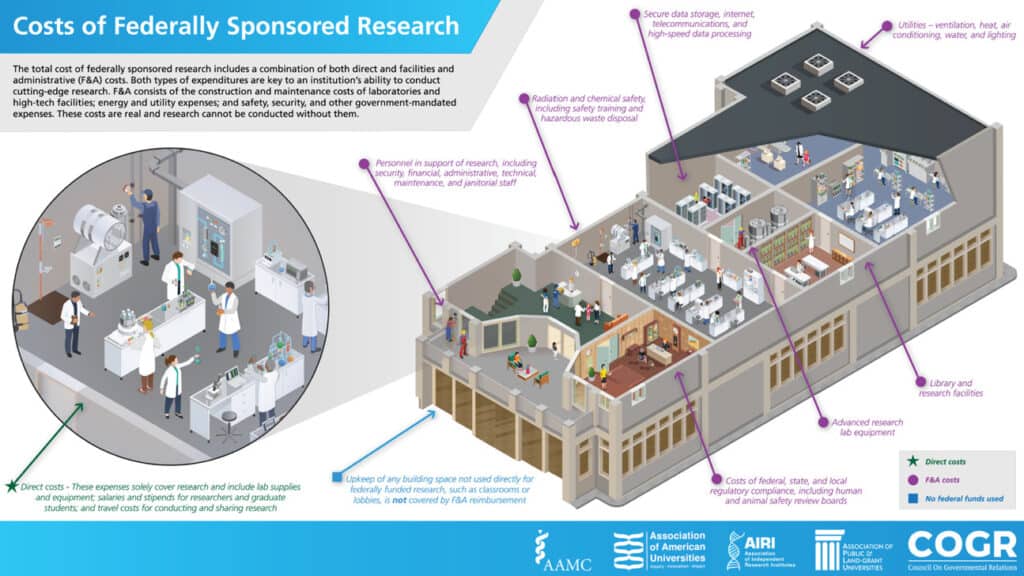Dravet Syndrome Foundation (DSF) was established in 2009 with a mission largely focused on funding and advocating for Dravet-related research. To date, DSF has directed over $10.5 million to support research. DSF’s Research Grant Programs provide essential funding for research focusing on Dravet syndrome and related disorders. These grants support early-stage research endeavors exploring hypotheses that have not been thoroughly investigated. The outcomes of this research serve as a crucial stepping stone, positioning it to be considered for larger-scale government funding in the future. Over time, DSF has been able to grow our Research Grant Programs, adding new categories, increasing funding-levels, and even funding larger-scale grants for a limited number of high-impact mid-stage research projects. Even with the impressive amount of research DSF has been able to support, the amount of progress that has occurred would not be possible without federal funding, particularly through the National Institutes of Health (NIH).
Without Federal Funding, Dravet-Related Research Would Stall

While DFS funding has continued to grow over time (graph above), the much larger investments by NIH (graph below) are necessary to cover the higher costs of fully supporting in-depth research projects. It has taken 15 years for DSF to build up to the impressive $10.5 million dollars awarded to research, but NIH has been able to direct more than $10.5 million yearly from 2018 until 2023 to Dravet-related research. NIH funding for Dravet-related projects has steadily grown over time, but took a major dip last year to levels not seen since 2015.

Federal Funding Supports the Entire Ecosystem of Research
Dravet-specific research depends on federal funding. DSF grant awardees have received over $35 million dollars in subsequent NIH-funding; these research labs that focus on rare epilepsies like Dravet syndrome are dependent on federal funding to continue operating.
In addition to research specifically focused on Dravet, federal funding for research through agencies like the National Science Foundation (NSF) and NIH also support basic science research that has laid the infrastructure for the scientific and treatment advancements that are occurring in Dravet syndrome. Sometimes these are targeted projects, such as studies to develop new technology to precisely deliver genetic therapies to the brain. Other studies may be even more removed from translational applications to human disease, but basic science research can lead to unexpected new tools to address disease. For example, CRISPR, which paved the way for targeted gene editing, was originally discovered by scientists studying bacteria.
Significant Cuts to NIH Funding Already Occurred in 2024
In 2024, the BRAIN Initiative saw a 40% reduction in available funding due to congressional cuts to the 21st Century Cures Act and direct cuts to the base allocation for the BRAIN Initiative (graph below) as part of an overall effort to reduce federal spending. The Brain Research through Advancing Innovative Neurotechnologies (BRAIN) Initiative aims to accelerate the development and application of innovative technologies to produce a new, dynamic picture of the brain. Projects funded through the BRAIN Initiative have laid much of the groundwork for our current understanding of neuroscience, feeding into the ability to study and develop treatments for Dravet syndrome. Continued cuts to federal funding allocations to support scientific research could considerably hamper progress towards the next generation of approaches to study and treat diseases like Dravet syndrome.

Indirect Costs for Research Grants at NIH and NSF are Being Cut
Earlier in February, there was a move to cut to billions of dollars in funding from the NIH and NSF by placing an immediate 15% cap on “indirect costs.” Indirect costs may sound like an easy target to reduce the budget line for the NIH, but this type of reduction could greatly risk the infrastructure at universities that support cutting-edge research.
The figure below details how indirect costs are utilized, including items like support staff to process grants, maintenance and utilities for laboratory facilities, management of hazardous chemicals, core facilities with advanced research equipment and expert support staff, technology support, and access to scientific research journals and library support. Many of these supports, like core facilities, allow the most advanced research institutions to perform cutting-edge science much faster and with less waste. Reducing the support for these infrastructure items, particularly without warning, could severely hurt universities and research institutions and hinder scientific progress.

Image from cogr.edu
Can Industry Fill the Research Gap from a Lack of Academic Funding?
Pharmaceutical and biotechnology companies also contribute large amounts of money and resources to support research, but there are limitations. Early-stage start-ups also depend on federal funding to support development of novel therapeutics or devices. Industry can be nimble and move quite quickly, but research efforts are generally limited by the potential financial gains from development of a product. Rare diseases are not usually an ideal target in terms of the marketing potential given the small patient population sizes, and are often only picked up after significant proof-of-concept studies have been performed in academic laboratories in established animal models. When a project hits a significant roadblock in an industry setting, it can be dropped and results may never even be shared with the scientific community. Academic research is not focused on the financial outcomes of the research, instead the goal is to test a hypothesis and report findings (positive or negative). For rare diseases, academic research creates a runway that can feed into industry pipelines with more confidence in outcomes.
Cuts to Programs and Staffing Could Hinder Rare Disease Drug Development
There are some federal incentives that help encourage rare disease drug development for pharmaceutical and biotechnology companies, but some of those programs are also being cut. One example is the Priority Review Voucher program through the FDA, which was cut from the congressional spending bill at the end of 2024, despite bipartisan support and no federal cost for the program. This program helps to offset the large costs and risks associated with developing a therapeutic for a rare disease, and has even been used by a company who brought a drug to market for Dravet syndrome in the past.. The Priority Review Voucher program has supported the development of 58 products since 2012, but without financial support the program is no longer available. It has been reintroduced in 2025 via the Give Kids a Chance Act, H.R. 1262, and will hopefully be passed to extend the program.
Cuts to government agencies that support research and drug development (NIH, NSF, CDC, FDA, etc), such as large reductions in staff size, also risk impeding progress across the entire research and treatment landscape.
What Can You Do to Support Research?
DSF will continue to work hard to fill research funding gaps where we can, and that is only possible because of the hard work of the patient-family community working to fundraise. This is more important than ever before, as the gaps in research funding are continuing to grow.
However, advocating with federal legislators to underline the importance of federal research support to you and your loved ones is also of paramount importance right now. If you would like more information on any of the policy initiatives that are relevant to Dravet syndrome and links to make contacting your representatives about these topics easier, visit AdvocateforDravet.org and check out this recent blog post that discusses non-partisan sources of information about rare disease legislative policies and simple ways to get involved in advocacy.

